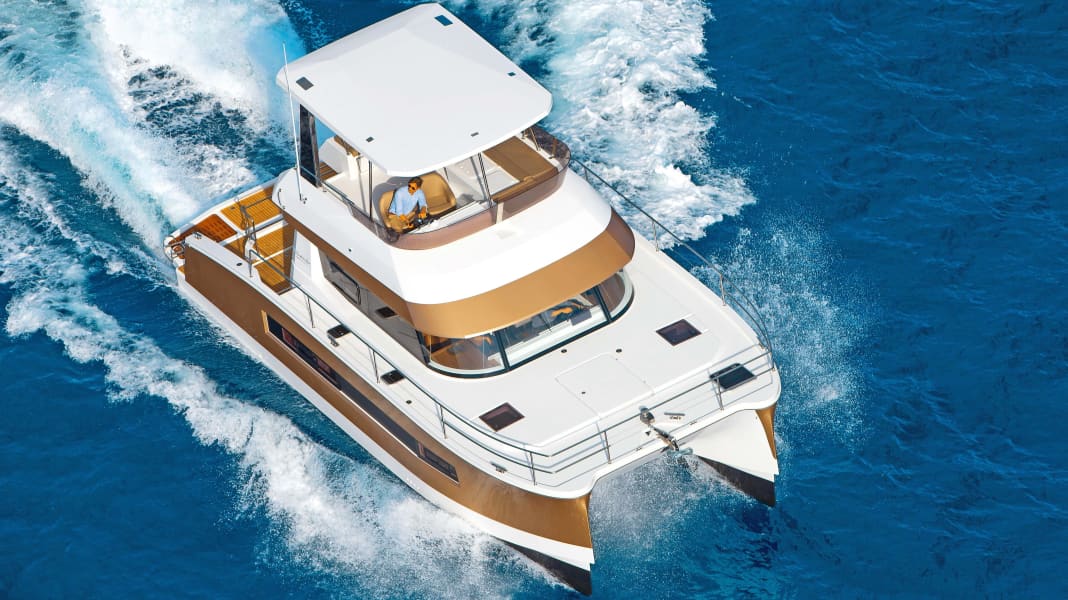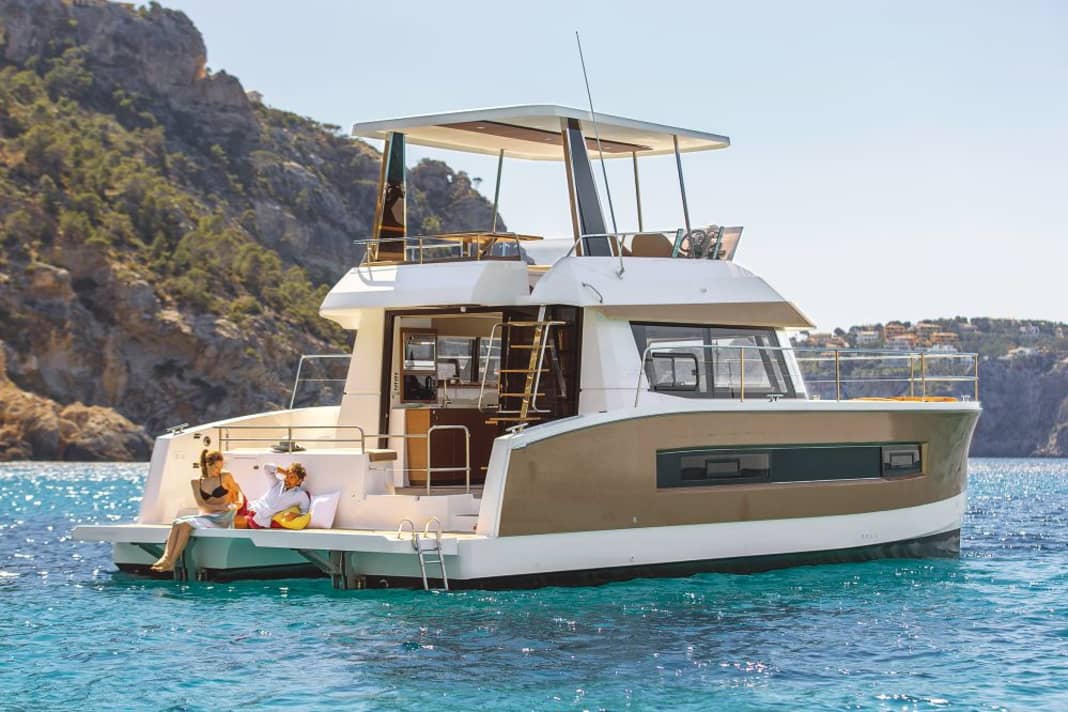






Founded in France in 1976, Fountaine Pajot is a family-run company that has been in business since 1983.one of the leading manufacturers of sailing catamarans. As if that were not enough, the company began producing its first motorised catamarans in 1998. Customers can currently choose from four models from 37 to 55 feet in length, which are offered in two categories: Catamarans and flagship catamarans. Our test boat MY37 belongs to the former, with the MY standing for motor yacht.
In the motorboat sector, catamarans are known as very fast boats that are more familiar from the racing scene. Let's say cabin cruiser catamarans have nothing in common with them.
Where is nowthe difference between a conventional monohull and the MY37, with the same engine configuration with two D3-220 hp diesel engines from Volvo Penta? While monohulls have a maximum speed of around 30 knots, we only measure a top speed of 20 knots for the MY37. This means that one tank of fuel (1200 litres) at slow speed (7 knots) is enough for just under 900 nm, at fast, economical speed (15 knots) just under 300 nm and at full throttle 211 nm, plus 15% reserve in each case.
Our test area is the islandPorquerolles in the south of France. This allows us to test the MY37 upwind and downwind in both calm and rough water. In short, the test boat cuts a very fine figure on both waters, whether travelling fast or slow. It doesn't matter whether waves roll under the boat, or whether you are travelling against or with the waves.
While on a monohull the drinking glass can spill over, on the MY37 you tend to look at the contents of the glass.
The concept of the boat's two hulls has a number of advantages over a monohull.all the trump cards on his side. Of course, the dimensions also play a major role. While monohulls have widths of plus or minus 3.60 metres, the MY37 only stops at 5.10 metres. And that sets new standards in terms of space and roominess.
Where a monohull of the same size can offer just two cabins and a bathroom with shower and toilet, an MY37comfortably twice as much - not to mention the space available in the saloon in the cockpit, on the flybridge and on the foredeck. Without the fourth cabin, you can use a hull solely for the owner, as on the test boat, and even a 50-foot boat can't compete with that!
But where there is light, there is also shadow. And with the MY37, this is not only evident when it comes to a berth.
With the width you literally also come up againstduring overland transport or on inland waterways when locking pleasure craft. These boats are therefore more likely to be found on coastal waters and in marinas, which have adapted to them and are becoming increasingly popular.
As far as the workmanship is concerned, especially in the interior of the test boat, it was noticeable that the shipyard had knitted the boat with a "hot needle",to keep the press deadline. If we had only seen this MY37, the rating would have been somewhat disappointing. But the shipyard has the potential and can certainly deliver very good quality, as the big sister boats at the event clearly prove.
In addition, the shipyard has assured us that there is still a lot to tick off the list on the test boat and that they would like to make some changes.
This also includes the engine compartment intake openings on "our" boat, which are fitted on both sides on the inside of the cockpit passages to the bathing platform. They whinelike overloaded speakers The noise of the engine depending on the engine speed reaches the ears of the guests on the cockpit bench. Nobody wants to hear that and demands that the intake openings be relocated to the outer walls of the fuselage. Because that's where they normally belong, even if they disturb the designer's sensibilities.
On the test boat, one could still criticise the fact that both steering positionsare not so equippedas you would normally expect on a motorboat, and that you have to stand up both at the helm station in the saloon and on the fly to operate switches. These are located aft in the saloon above the seating area in the electrical panel. TheStandard motorisation are two Volvo Penta diesel engines with 110 hp each.
We drive the more powerful version, which also brings its performance into the water by means of shaft drives.
The engines are located aft in each hull, and the engine compartments are accessible from above via large hatches. Boarding is more or less comfortable and requires the skipper toa little sportiness. Everything in the engine compartments is easily accessible, which benefits daily checks and servicing.
The shipyard equips the MY37 ready to go and offers a well-stocked list of accessories that contribute to customisation and comfortable living on board.
Our test boat is equipped with a fixed bimini over the flybridge, which is particularlyLong journeys under the hot sun favoured. If the fixed canopy casts too much shade on the sun loungers, you can simply move to the extended foredeck, which could also be called a "veranda". As far as safety is concerned, the driving characteristics are definitely impressive. Incidentally, if the number of handholds were increased and the railing were a little higher, nobody would have any objections.
Conclusion
If the shipyard delivers the standard of workmanship on the MY37 that we have seen on the large catamarans, the boat can serve as a "springboard into the catamaran world". What is tempting is the amount of space on and below deck, which is otherwise only found on much larger monohulls as described above. But these are only half boats, aren't they?
Data sheet: Fountaine Pajot MY37
Shipyard: Fountaine Pajot
Type designation: Fountaine Pajot MY37
CE category: B - Outside coastal waters
Material of hull and deck: Plastic
Length: 11,00 m
Width: 5,10 m
Displacement: 8,90 t
Price: 339.649,00 €
Downloads:
download

